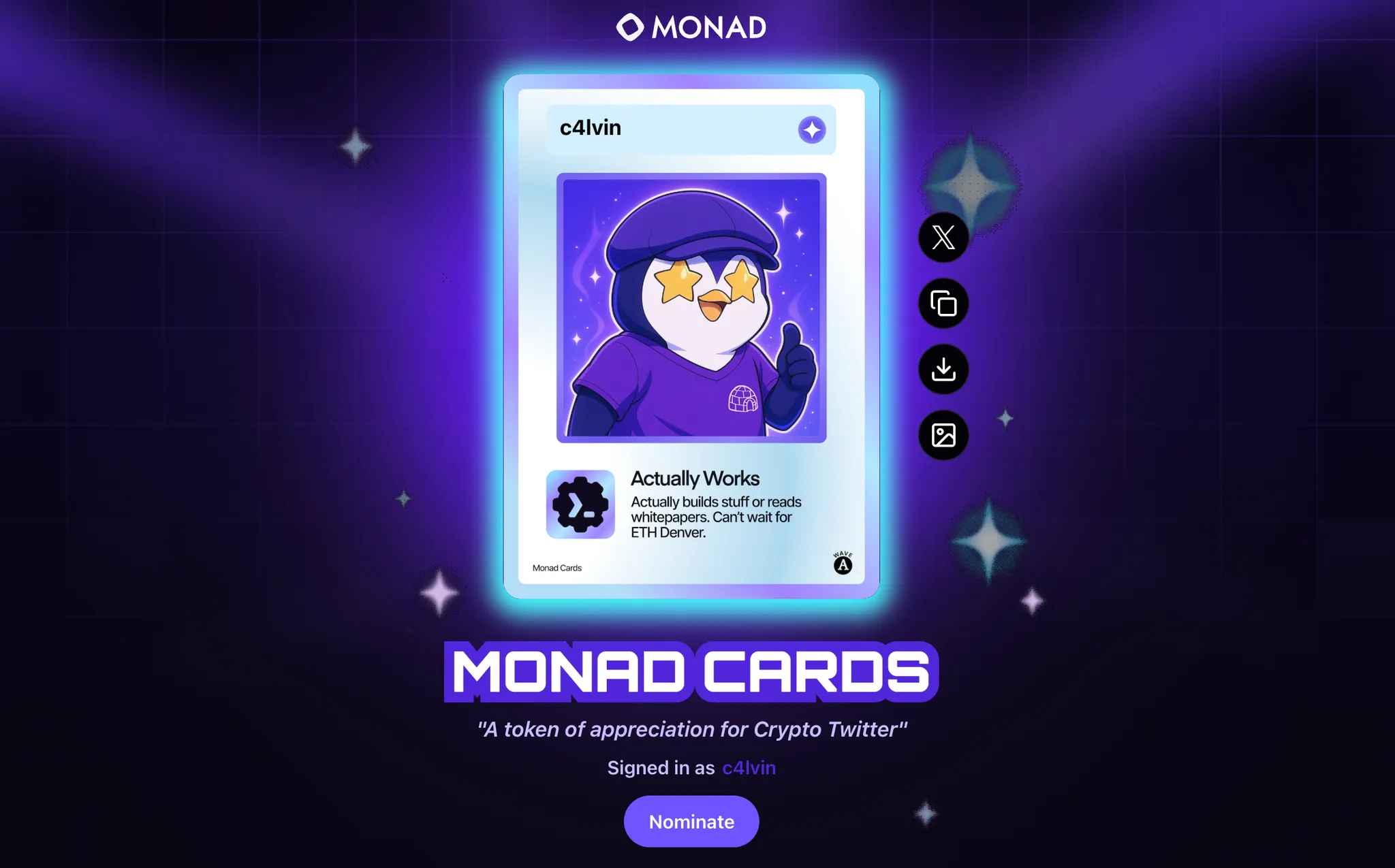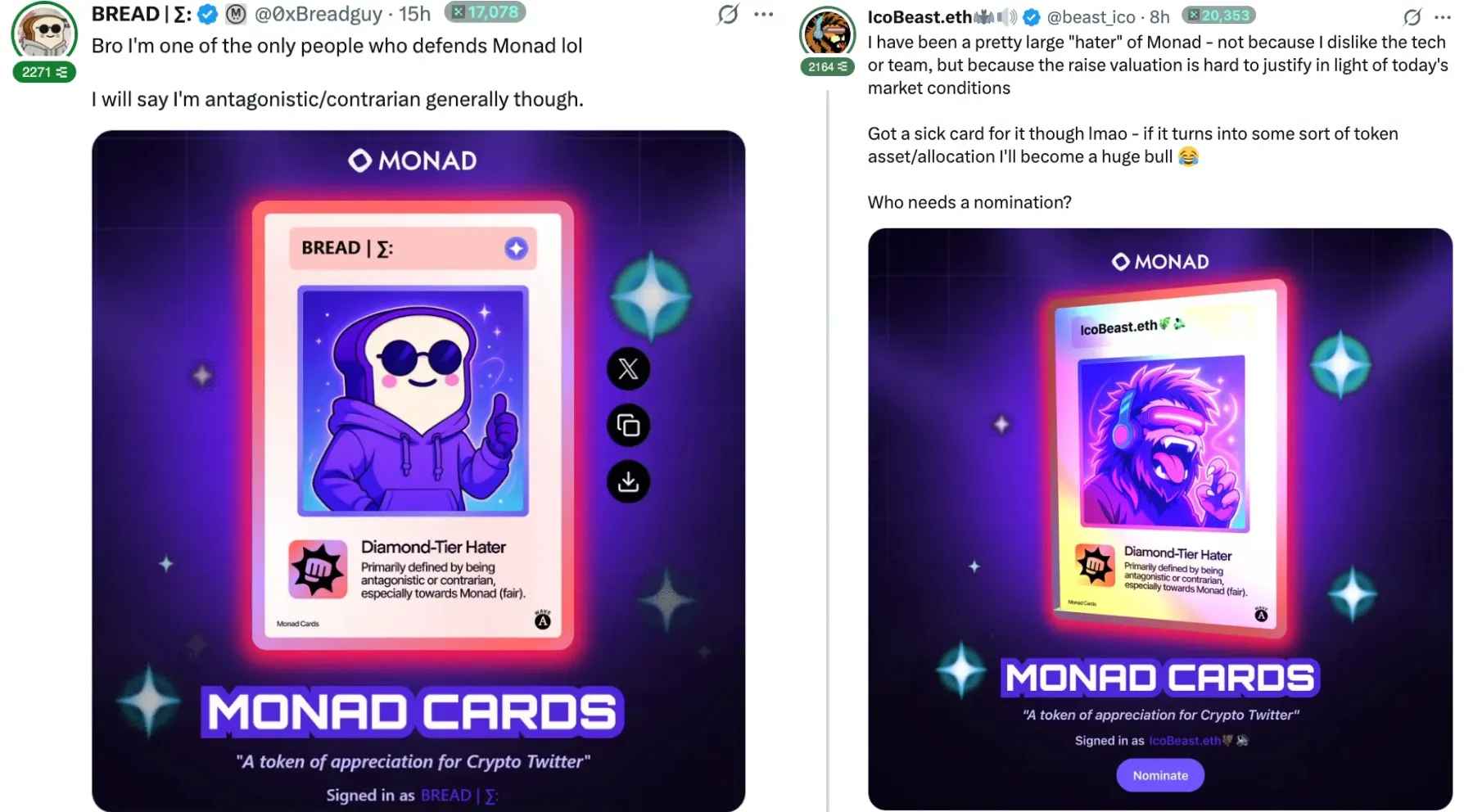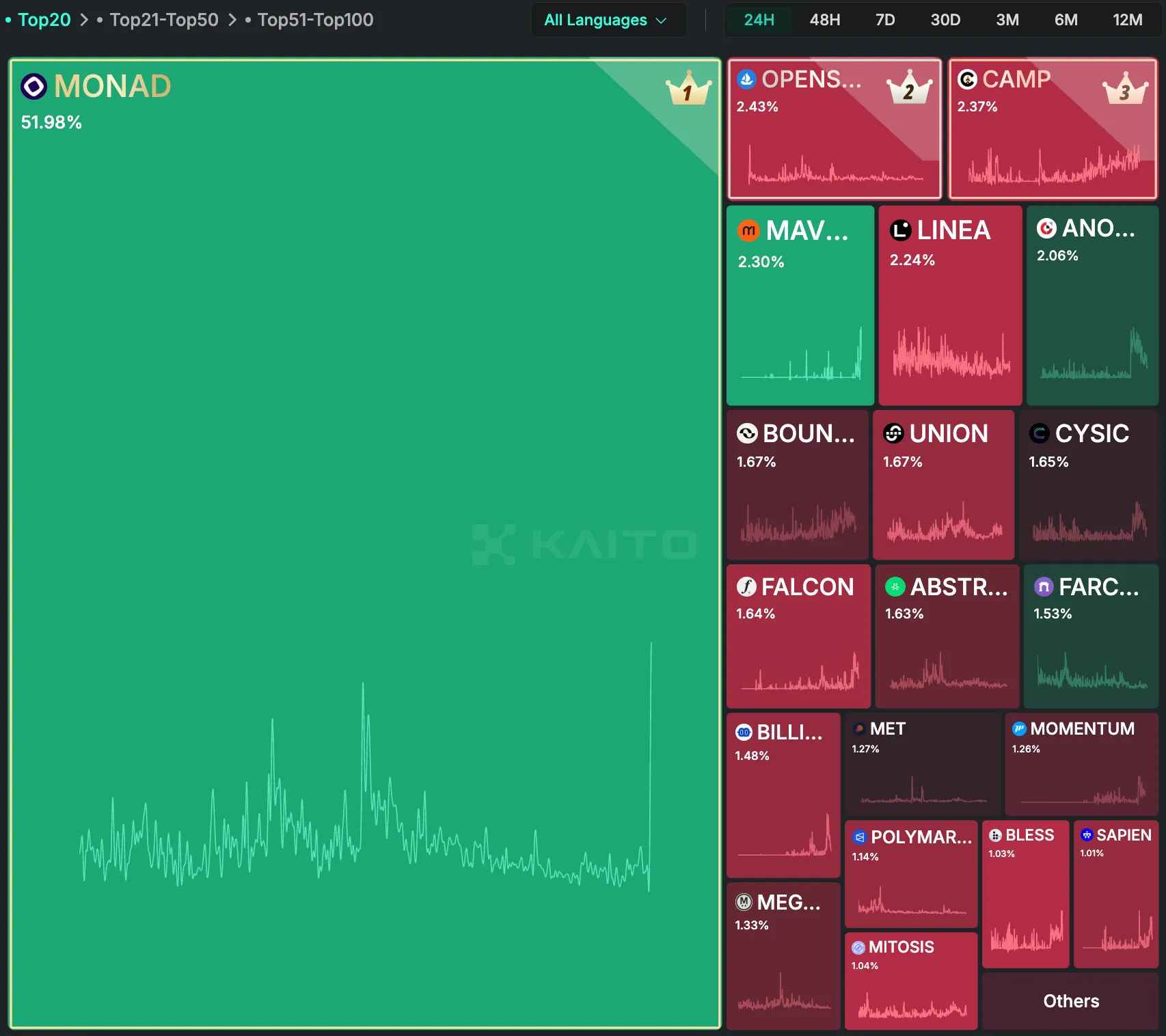Today, Monad manually curated 5,000 influential accounts across various role groups (OG, builders, KOLs) and distributed "Monad cards." This selective approach secured mindshare from major opinion leaders while, combined with a recommendation system for subsequent allocations, generated massive FOMO.
Monad proactively embraced critics and skeptics, converting them into community members by granting recognition to a large number of mid-tier opinion leaders. This "minimize enemies" approach proved that inclusivity can be more powerful than defensive tribalism.
While smaller projects continue to leverage quantitative platforms like Kaito for efficient community building, larger projects are expected to shift toward manual and qualitative curation. Monad's labor-intensive approach of reviewing over 10,000 profiles to select 5,000 recipients signals that authenticity and genuine care resonate more than automated point systems.
Yesterday, @monad announced an event named 'Monad Cards', allowing approximately 5,000 X accounts to mint cards as a token of appreciation to the whole CT.

Source: Monad Cards
The core of Monad Cards reflected CT's social graph by analyzing accounts followed by reputable figures across various sectors in the crypto ecosystem. Each member was assigned manually curated roles such as OG / Actually Works (researchers, builders) / Big Poster (KOL) to identify the unique value they provide to the crypto community. This selection was based on actual influence and contribution, directly reviewed by team members, rather than superficial metrics like follower count or tweet frequency.
This minting represents the first wave of Monad Cards, with a separate nomination system for the second wave. Those who minted cards through Wave 1 can nominate up to 3 candidates, who will be included as Wave 2 recipients on a first-come, first-served basis after team review. However, if inappropriate individuals are nominated, the nominator's own card will be burned, enforcing recommendations of only trustworthy community members.
Monad community was famously hardcore. Monad had been building its community for nearly three years, during which a strong inner circle formed, deeply embodying the project's identity and culture. Roles like NadOG and Monvangelist were special statuses granted only to members who had shown long-term dedication, creating a barrier difficult for new participants to overcome.

Source: @mongdiny7
While the long-built community had tremendous cohesion, it simultaneously created an environment difficult for new participants to understand and integrate into. Particularly, the numerous mascots and memes related to Monad's 'purple' branding functioned like an internal language incomprehensible to outsiders.
Additionally, the Monad community periodically conducted 'purges' to remove inactive or low-contributing members, and the content bar for community entry was quite high. Simple "Monad to the moon" yapping wasn't enough for recognition - deep technical understanding or (extremely) creative meme production capabilities were required. While positive for quality control, this clearly limited mass adoption.

Source: @0xBreadGuy, @beast_ico
One of Monad Cards' most remarkable achievements was embracing influencers who had been critical of the project. Monad included CT influencers like @beast_ico and @0xBreadguy, who had maintained skeptical or critical positions toward Monad, in Wave 1 selections, and gave them a special role called "Diamond Tier Anti," acknowledging their awareness of criticism toward the project.
However, Monad's approach created an atmosphere where card recipients felt compelled to express gratitude, and indeed, these individuals showed appreciation for being selected. Through this "minimize enemies" strategy, Monad created a starting point for building an inclusive ecosystem by acknowledging and embracing critics as part of the community, reducing unnecessary FUD.

Source: Kaito 7D Mindshare, as of 2025-08-20 13:00 KST
According to Kaito, Monad captured nearly 30% mindshare on Crypto Twitter immediately after the announcement (and now 50%). This is a phenomenal figure for a single project, demonstrating the massive buzz Monad Cards generated. This was the most encouraging mindshare capture success since Loud!, serving as the best example of how effectively a strategy of embracing broad opinion leaders can work on CT - a level of success not seen even right before TGEs of famous projects.
Monad Cards' allocation went through direct review by the Monad team, including many KOLs with ambiguous follower counts in the thousands. While not major influencers, these are influencers who exert meaningful influence in their respective domains. The feeling of being "recognized by an influential project" can serve as significant motivation for them, naturally leading to positive content production about Monad. This was an effective strategy for bringing many mid-tier influencers into the community at relatively low cost.
Additionally, the nomination system made many small-to-medium opinion leaders feel inferior compared to this selection. The question "Why wasn't I selected?" naturally leads to "How can I be selected next time?" This connected to deeper interest and more active participation in Monad to receive nominations, which I evaluate as a very strategic use of FOMO.
Recently, crypto projects have tried to secure influencers through Kaito's Yap farming program. Users compete for mindshare through crypto-related posts, with some users posting over 200 posts per day. However, since Kaito takes a thoroughly mechanical and quantitative approach, the crypto community has become absorbed in "Kaito-friendly posting," creating significant fatigue. In this situation, Monad Cards' selection method was perceived as qualitative and humane, leading to positive evaluation.
Also, while Kaito yapping is efficient, it resulted in influential opinion leaders being fragmented across multiple projects. It was more about point farming than genuine attachment to specific projects. However, new chains aspiring to develop into major chains cannot succeed with just partial communities alone, and bringing in key opinion leaders from broad communities is crucial. But forming an Ethereum or Solana-level KOL community as a new chain is extremely difficult, and it's been sufficiently proven that this cannot be achieved with money alone. To achieve this, it's important to instill the perception itself that "the project genuinely values the community."

Source: @keoneHD
Monad is estimated to have reviewed at least 10,000 CT profiles to select 5,000. Even if they referenced Kaito Yap rankings, assigning unique roles to each account and directly verifying them requires enormous effort. In particular, Monad co-founder Keone Hon posted a thread on X that tagged all 5,000 people selected for Wave 1 shortly after the distribution of Monad cards, revealing that they were all manually screened.
The fact that the team consumed this much labor to differentiate the community was direct evidence of how seriously the Monad team views the community, and it was an approach that made everyone feel the "thoughtfulness."
I expect that approaches treating individuals who produce influential and meaningful content better, like Monad Cards, will be increasingly adopted by many projects.
A representative project that took a similar strategy to Monad is MegaETH. MegaETH announced 'The Fluffle', a collection of 10,000 soulbound NFTs, and similarly to Monad Cards, distributed the first 5,000 NFTs to developers, security researchers, NFT diamond hands, and KOLs. This was also selective distribution through manual review.
Larger projects have enormous demand for large-scale opinion leaders. Projects need to organically onboard them without direct investment deals, but Kaito's quantitative metrics alone make it difficult to distinguish genuine influencers from simple farmers, and large-scale KOLs also have very high standards for project selection.
I expect future social strategies to split into two:
1) Small-to-Medium Projects: Kaito-Centric
Meaningful but smaller projects with limited capital and target market size can quickly form initial communities through Kaito. Kaito uses AI algorithms to track social graphs and semantics, measuring actual contribution beyond simple metrics like likes or comments. This enables efficient community building with limited resources.
2) Large Projects: Preferential Treatment for Influential Individuals Including Large Opinion Leaders
Like Monad's strategy, the larger the project scale, the more important it becomes to increase mentions from big opinion leaders even slightly. Therefore, the "minimize enemies" community strategy will prevail, and securing many influential individuals can trigger trickle-down FOMO effects at least within the crypto community. This is because their single word influences thousands or tens of thousands of followers.
Monad Cards presented a new paradigm for how Web3 projects engage with communities, beyond a simple marketing campaign. It showed that building authentic communities is possible through qualitative evaluation and human approaches, not relying on quantitative metrics.
Particularly, the inclusive approach embracing even critics, recognition and motivation for small-to-medium KOLs, and the nomination system where the community itself expands the community are elements worth referencing for other projects. Going forward, large projects will likely attempt to build communities based on actual influence rather than simple numbers through such selective yet inclusive approaches.
Related Articles, News, Tweets etc. :